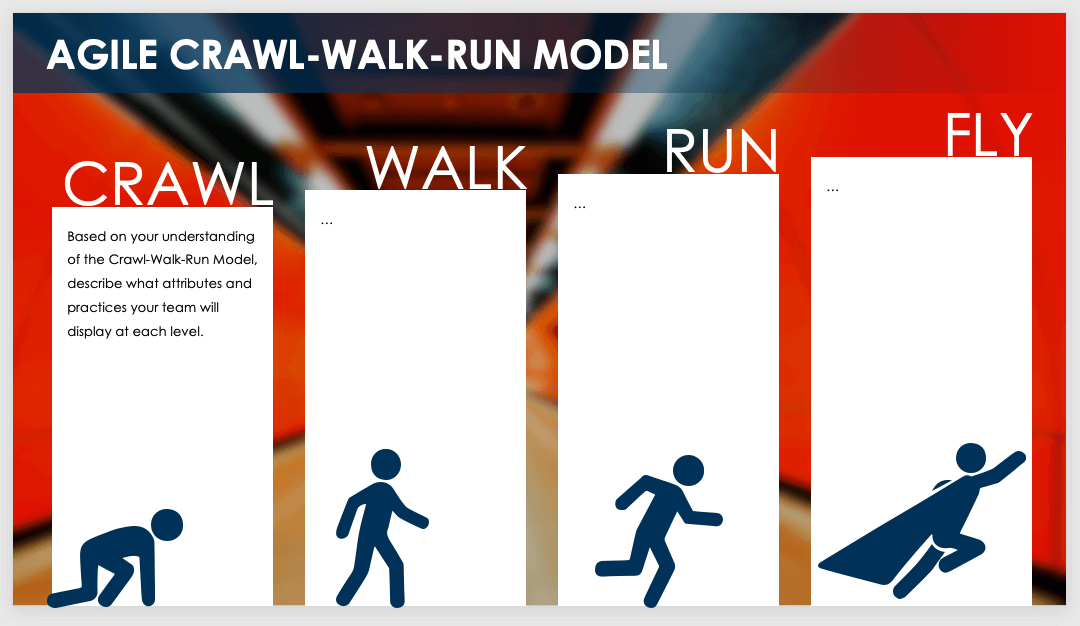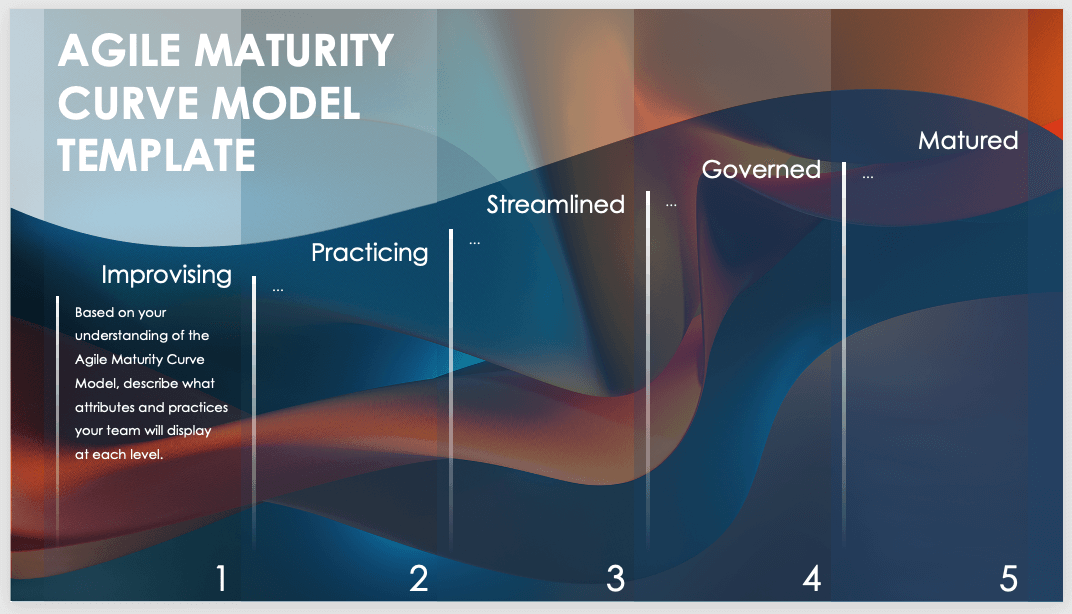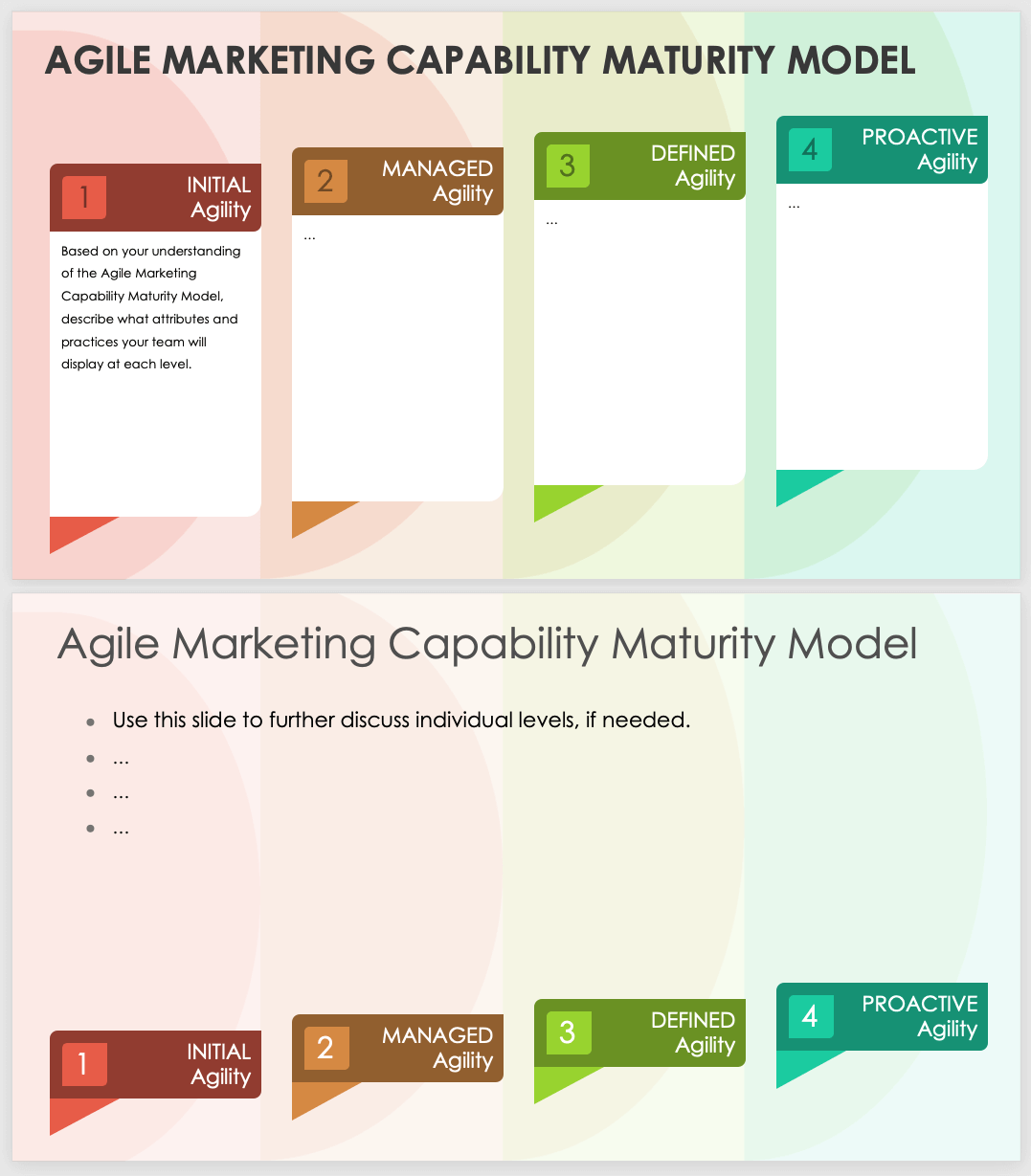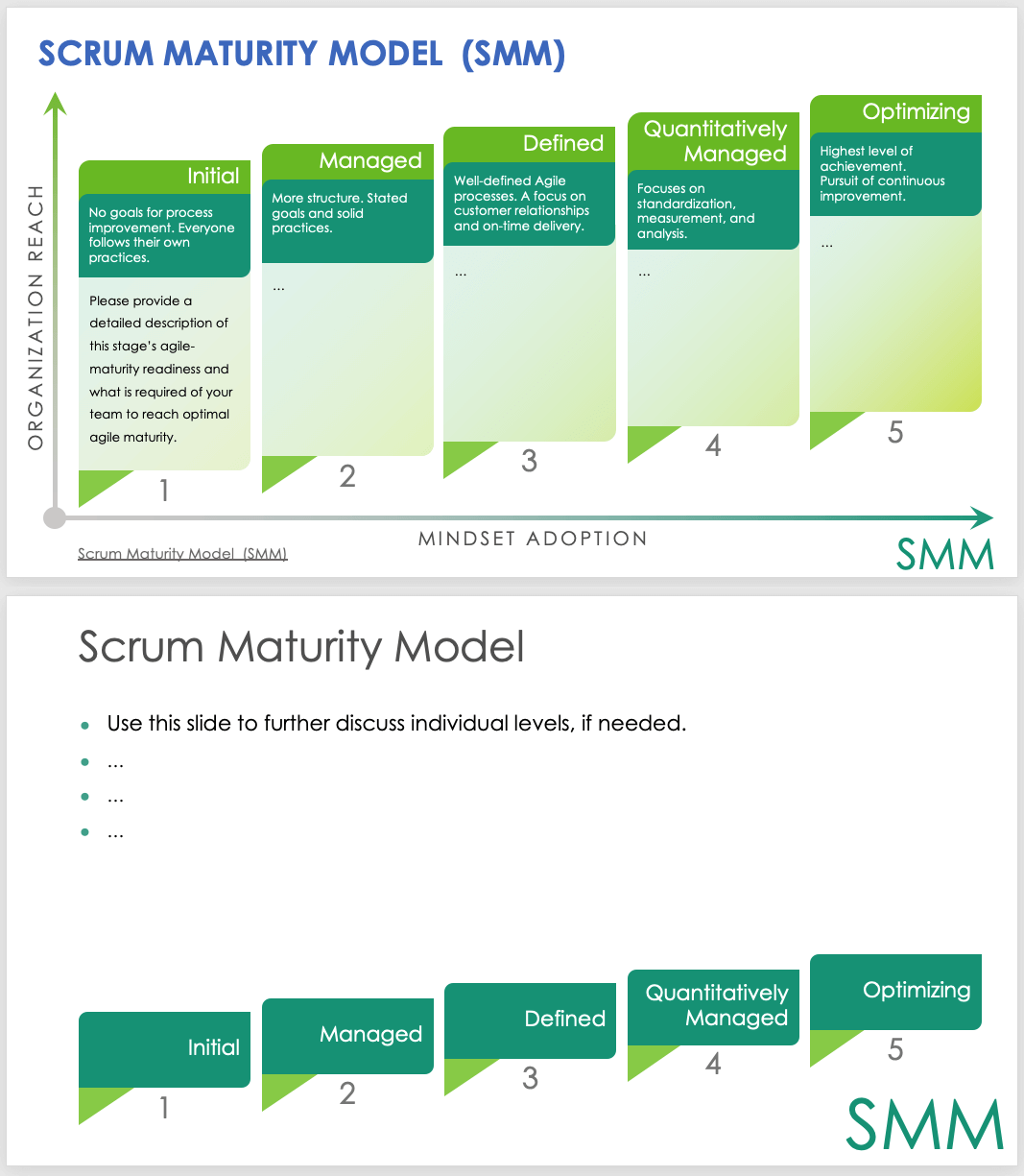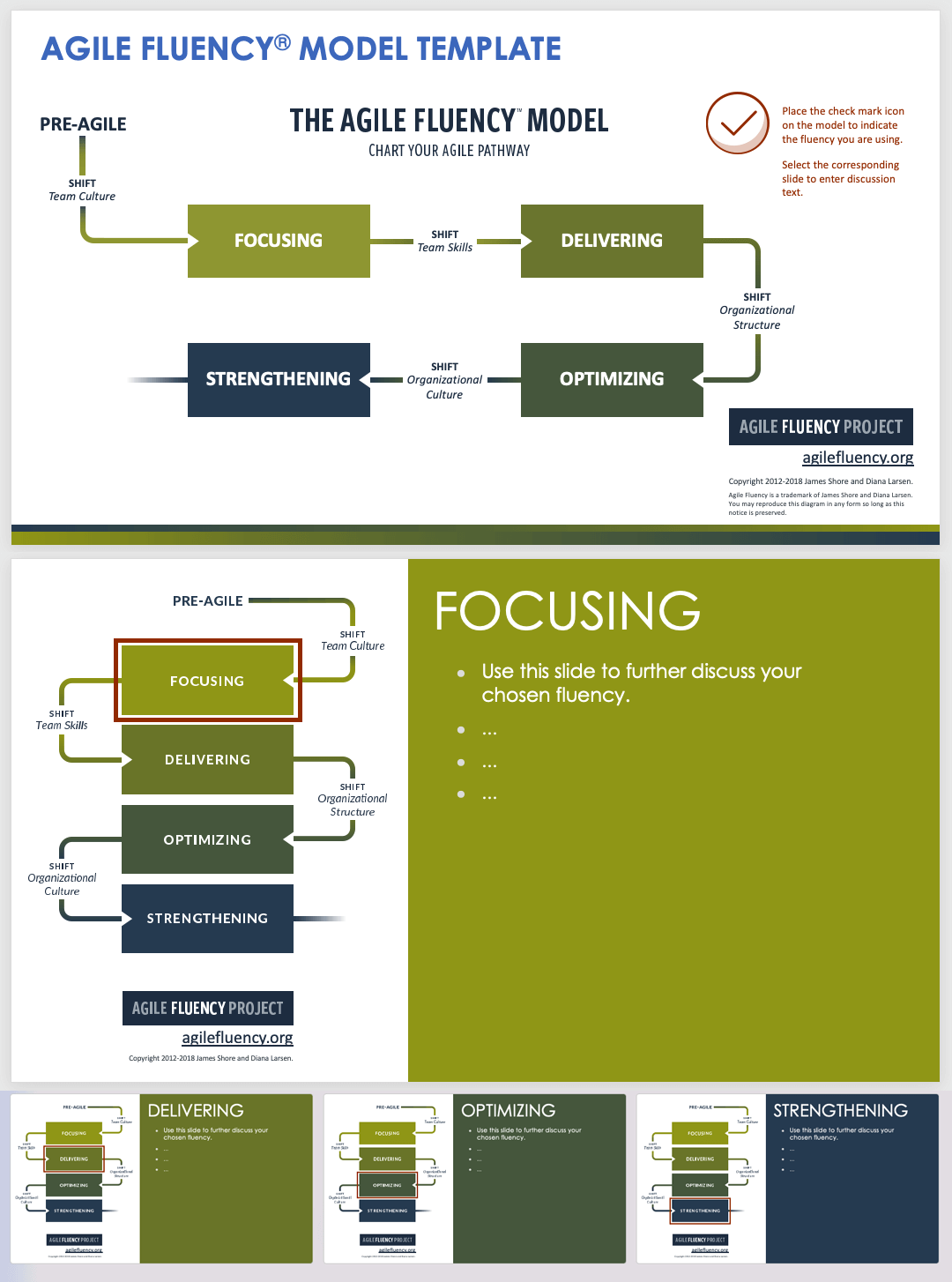What Is Agile Maturity?
Agile maturity is a measure of how well your Scrum team uses and improves Agile practices. Your team is at peak maturity when everyone embodies Agile values. A mature team also continuously improves its Agile processes.
In project management, Agile methodology is an approach where teams deliver many working versions of a product that provide value to the customer. The Agile approach is iterative and allows highly collaborative and communicative teams to rapidly respond to customer feedback. Agile teams create products or services during short iterations, often called sprints.
Unfamiliar with Agile terms? See this Agile dictionary to learn the lingo. For more general information about implementing Agile project management, see this comprehensive guide. To find even more resources, try one of these free, downloadable templates for Agile project management.
A mature Agile organization will follow these 12 Agile principles:
- Customer Satisfaction: Pleasing the customer and delivering value are the team’s highest priorities.
- Changing Requirements: Even late in the sprint, the team welcomes change, as long as it promotes a competitive advantage for the customer and your company.
- Frequent Delivery: The company delivers a minimum viable product (MVP) in the shortest possible delivery cycles.
- Balanced and Cross-Functional Team: Product creators and business teams work together throughout the delivery cycle. Teams are cross-functional and have T-shaped skill sets, meaning individuals have deep knowledge in one or two disciplines, along with sufficient knowledge in a variety of other disciplines.
- Supportive Environment: Products or services originate from motivated people who have the tools, culture, and support to perform well. Management trusts team members to do the work.
- Direct Communication: Team members and others communicate face to face, work in the same office area, or have flexible and robust collaboration tools.
- Product Progress: Working products define progress.
- Sustainable Effort: Work happens at a pace the team can sustain without all-nighters, weekend work, or other heroic efforts.
- Technical Expertise: Teams value and strive for quality in processes and designs. Team members focus on technical excellence and quality.
- Efficiency: Teams are efficient. They aim to work smarter, not harder.
- Self-Organizing Teams: Teams plan and prioritize their own work so that they can deliver the best results.
- Continual Improvement: The team regularly considers how it can improve practices or build on existing successes.
A mature Agile organization may follow the Agile principles, or the Agile Manifesto, which values individuals and interactions, working software, customer collaboration, and the flexibility to respond to change.
Achieving high maturity in Agile methodology also provides the same benefits as it does in traditional Waterfall project management.
These benefits include:
- Better Communication: Plans prevent misunderstandings and provide direction.
- Clearer Contracts: Contracts provide an initial agreement between customers and vendors on project aims.
- Fewer Errors: Documentation, such as basic requirements and change notes, helps reduce and trace defects.
- Improved Consistency: Tools and processes provide repeatability, transparency, and traceability.
The key element to understand when pursuing maturity is that Agile is a culture, not a fixed set of protocols. “The thing that most people get wrong about Agile is that agile is nothing but a mindset,” says Drew Podwal, a New York City-based Agile coach who focuses on developing teams’ Agile capabilities. “If you read the Agile Manifesto, there's nothing that says, for example, there are five business days in a sprint or that a user story must be sized using Fibonacci or even any mention of a Scrum master or product manager. It talks about how we communicate and what values we have, and that we will uphold delivery of the highest value to our customers.”
Agile Maturity Goals
The goal of Agile maturity is to help teams create value effectively. Agile management helps teams respond to customer needs, as well as market and supply chain changes. Agility keeps you competitive in a dynamic business landscape.
Organizations need flexibility — or agility — in order to thrive. Agile maturity provides fine-tuned capabilities and practices that reduce costs, improve quality, and shorten the time between planning and releasing to the market.
Agile Maturity Assessment Questionnaire Template for Excel
Download the Agile Maturity Assessment Questionnaire Template for Excel
Use this downloadable questionnaire template to determine the maturity of your Agile practices. The template is completely customizable so you can adapt questions to better reflect your practices. Install it on a shared drive so that all stakeholders can access it. The digital version calculates results and displays them on the radar chart tab. Alternatively, you can print the Agile Maturity Assessment tab and distribute it for users to write in their responses.
Before you start, explain to your team that understanding Agile maturity is helpful for goal-setting and planning purposes. Reassure survey takers that answers are anonymous or confidential within the team and that no person or team are graded or judged by the results.
What Is an Agile Maturity Model?
An Agile maturity model is a tool that helps teams assess their Agile capabilities. Using a maturity model also helps teams choose helpful performance goals. By doing so, they can improve skills that will advance their Agile maturity.
Although Agile methodology has its origins in software development, Agile maturity models can be helpful for managing projects in any sector.
Here are some examples of popular Agile maturity models. Use the following templates for presentations when you discuss Agile maturity initiatives:
Download an Agile Crawl-Walk-Run Model Template for
PowerPoint
| Google Slides
Crawl, Walk, Run: In his book Good to Great, Jim Collins describes a sustainable improvement approach with his Crawl, Walk, Run model. This model encourages teams to build solid foundations for further advancement at each step. In an Agile transformation, rather than make many big changes at once, teams begin experimenting with Agile frameworks, such as Scrum, and introduce new practices slowly until teams fully embrace Agile methodology.
Download an Agile Maturity Curve Model Template for
PowerPoint
| Google Slides
Agile Maturity Curve: The Agile Maturity Curve is a five-stage model that details practices that remote Agile teams should implement at each stage. The curve is steep in the second and third stages and flattens as teams approach peak Agile maturity.
Download an Agile Marketing Capability Maturity Model Template for
PowerPoint
| Google Slides
Agile Marketing Capability (AMC): Two scholars proposed this four-level maturity model in their Tourism Management article “An Agile Marketing Capability Maturity Framework.” The model evaluates organizational maturity for customer-oriented responsiveness, flexibility, collaboration, and continuous improvement.
Download a Scrum Maturity Model Template for
PowerPoint
| Google Slides
Scrum Maturity Model (SMM): Alexandre Yin of the Technical University of Lisbon developed and tested his Scrum maturity model (SMM), which provides teams with specific steps for implementing Scrum practices that improve development processes and redirect focus toward customer involvement.
Download an Agile Fluency Template for
PowerPoint
| Google Slides
Agile Fluency Model: This model helps teams internally assess what capabilities they need to reach their business goals, rather than comparing them to an external benchmark. The Agile Fluency Model is not a maturity model. Teams may start anywhere among the four fluencies: focusing, delivering, optimizing, and strengthening.
Agile Levels of Maturity
Agile maturity levels are the stages companies advance through from lowest to highest maturity. Each level defines the actions, capabilities, and values that teams and organizations have at that stage of maturity. Understanding each level helps companies improve their processes.
Each stage in an Agile maturity framework suggests specific actions and behaviors that teams can take to bring them to the next level. The Agile maturity continuum of most models ranges from an initial or ad-hoc level with few or no Agile practices to a fully adapted, continuously improving level.
Here are examples of five Agile team maturity levels:
- Level One: Also called level zero, ad hoc, initial, or stagnant level, level one indicates a lack of Agile knowledge or activities. Characteristics of this level include a lack of alignment between business and IT goals; absent, manual, or undocumented processes; few and irregular releases; a lack of bug tracking; detailed requirements documents; few or no metrics; functional silos; reliance on heroic behavior for success; and command-and-control leadership.
- Level Two: Often called repeatable or in-transition level, this level indicates shared goals, teamwork, and a desire to produce value. Teams introduce some process automation, produce more frequent releases, and explore Agile frameworks, such as Scrum, Kanban, or Extreme Programming (XP).
- Level Three: Often called the consistency or sustainable maturity phase, this level indicates that the organization fully embraces Agile principles and adapts Agile frameworks as needed. Processes are repeatable and automated, work is tracked and measured, and management adopts a servant-leadership approach.
- Level Four: Often called the measured or quantitatively managed phase, the fourth maturity level indicates that a team or organization can be considered Agile. The entire organization understands its strategy and objectives, which exist to create value. Teams regularly evaluate progress, and the organization experiences more successes in product development than failures.
- Level Five: Often called optimized or innovating, this ultimate Agile maturity level indicates that all activities contribute to creating value. Organizations at this level experience limited defects. They feel free to report and fix bugs without fear of reprisals, as well as automate appropriate processes. Management shepherds the organization with a systems-thinking approach — a holistic understanding of how all individuals and teams interact to create outcomes.
In a survey conducted by the low-code development platform OutSystems, about 60 percent of respondents said they were in the second or third Agile maturity stages. Only about 15 percent ranked their organizations as fully mature in Agile. OutSystems concluded that most companies surveyed are still forming an Agile culture and therefore have yet to start measuring and improving practices.
What Is an Agile Maturity Matrix?
An Agile maturity matrix is a visually dynamic self-assessment tool that helps teams monitor the effectiveness of their Agile practices. A matrix also allows teams to share results among team members, executives, and Agile coaches.
The following is an example of the content and format of an Agile maturity matrix. You can download the full image to see the categories and statements a matrix includes.
Challenges of Agile Maturity Models
Most challenges of Agile maturity models come from the presumption that growth is linear. Another major problem is inconsistency between models. Finally, employees might misinterpret maturity levels as value judgments. These employees will be discouraged, not motivated, by low scores.
Several academic studies have raised concerns about the lack of a widely accepted benchmarking model for Agile maturity and the variability of criteria among Agile maturity models. In their Communication and Computer Science article, “Assessment of Agile Maturity Models: A Multiple Case Study,” Ozden Ozcan-Top and Onur Demirörs surveyed nine models and found them inconsistent and ineffective for gauging maturity.
What’s more, in a more recent study from the Journal of Systems and Software, “Understanding the Order of Agile Practice Introduction: Comparing Agile Maturity Models and Practitioners’ Experience,” researchers reviewed 12 Agile maturity models and reached a similar conclusion. Most models differed in key categories, such as the order for introducing practices and what Agile methods and characteristics constitute a given maturity level. These models rarely provided reasons for introducing practices at specific maturity levels and did not suggest how long a team should follow a practice before it advances to the next level. Furthermore, when surveying Agile users, the researchers found that teams introduced Agile practices in a different order from those prescribed in most models.
In addition, these researchers found that a maturity model might not be the best approach to gauging a flexibility-oriented philosophy such as Agile. “The notion of combining Agile with a hierarchical model like a maturity model that is often associated with plan-driven [Waterfall] development seems to go against the value of Agile. The AMMs [Agile maturity models] themselves follow hierarchical maturity models which often assume that the development process would be predictable and consistent,” they write.
Some practitioners also believe that maturity focuses on the wrong aims. Models might incline people to focus on processes, whereas Agile companies in today’s industries need people with problem-solving skills. If handled poorly, assessment results can make people feel that they are judged as immature. A model can also give managers a false sense of control over the subtle and complex experience of guiding people. “Maturity seems theoretical to teams, and when they're required to meet certain metrics or performance indicators, they often focus on gaming the assessment process or they give up, rather than actually improving,” suggests Andrew Stellman, a developer, architect, Agile coach, and six-time O'Reilly author.
Stellman recommends the following ideas for improving Agile maturity:
“On the other hand, focusing on capabilities means looking at what people really do,” he says. “Do they really deliver products regularly? Do they respond to requests quickly? If something fails, can they recover quickly? In many organizations, maturity is about meeting a specific set of documented criteria, but capability is about getting better at what you do.”
“If the team sees the Agile maturity assessment as a tool for itself, versus a tool for management, it frees them up,” says Alan Zucker, founding principal of Project Management Essentials. “They're not trying to do things because leadership says we need to be at maturity level x in one area. The team is using this as a way of gauging its own performance and its own improvement over time.”
What Is an Agile Maturity Assessment?
An Agile maturity assessment is a tool that helps measure how well you perform Agile practices. It also measures your readiness to adopt more Agile practices. In addition, an assessment helps your team agree on your current Agile maturity.
Organizations sometimes conduct assessments after multiple failed attempts to implement Agile practices. Teams might also test before and after an initial Agile project in order to gauge how well the team accepts and understands Agile practices and values. A team should also test at regular intervals to monitor improvement targets. When an organization collects assessment results, it can then prioritize areas for improvement. These areas for improvements will also help managers determine the Agile metrics they need to track progress.
Different assessments measure different areas of maturity. For example, the Karlskrona Agile maturity assessment survey uses 11 plain-language questions — that is, without Agile lingo — to gauge adherence to Agile principles. Other surveys borrow elements from project management and process maturity models to measure process standardization and devolution of decision making. Some assessments ask questions about culture and governance.
Individuals, teams, or entire organizations might take self-administered assessments. There are both free and paid options for these assessments:
- Free and Online: For example, teams can try the Karlskrona Test or the Crisp Team Barometer Self-Evaluation.
- Free and Paid: For example, teams can try the Comparative Agility assessment or the World Index benchmarking database, which includes training and other benefits for paid users.
Assessments might test whether a team is doing Agile or being Agile. Teams are doing Agile when they perform Agile activities, such as observing Scrum ceremonies and pair programming. Teams are being Agile when they use Agile principles to solve new problems and management supports self-organizing teams and decentralized decision making.
Here are a few examples of how an Agile maturity assessment can map to the 12 Agile principles listed above:
| Assessment Statement | Agile Principles Behind the Agile Manifesto |
|---|---|
| We frequently release working products. | Principle 3: Frequent Delivery |
| Team member time is dedicated to the project. | Principle 5: Supportive Environment |
| We conduct daily standup meetings. | Principle 6: Direct Communication |
| The team is collocated or has robust collaboration tools. | Principle 6: Direct Communication |
| The team is self-organized and makes its own work decisions. | Principle 11: Self-Organizing Teams |
| We hold retrospectives. | Principle 12: Continual Improvement |
A cost-effective and lightweight option for some organizations is to create new assessments to fit their needs. Teams can also base a custom assessment on a suitable free assessment template. In an internal questionnaire, consider limiting the number of assessment areas and focus on elements that a team can influence. For new Agile teams, include questions about how teams prioritize work, their attention to continuous improvement, and their ability to estimate effort. For a scoring scale, you might choose a Likert scale of one to five.
However, opinions about homegrown assessments vary. Zucker says collecting metrics is a double-edged sword because, as management guru Peter Drucker said, what gets measured gets done. But not everything that can be measured matters. “How do we collect metrics, and how do we use metrics?” wonders Zucker. “If we're using a metric of agility, I would strongly recommend that the organization, rather than coming up with their own measures, use an industry-based tool. If we're designing a survey, it has to be unbiased. Designing surveys is a specific skill. The words can make us collect biased data.”
Additionally, for an assessment to provide value, you have to consider the benchmark. “Comparing you to me is not very valuable, but comparing me today versus me three months from now, or six months from now — that's where the value lies,” Zucker explains.
How to Do an Agile Maturity Assessment
Use an Agile maturity assessment as a self-evaluation tool or through a third party. An assessment can be administered online or in person, to an individual or group. Keep all answers anonymous and confidential to encourage honest reflection.
Here are some key considerations for conducting an assessment:
- Consider the Format: Some assessments will be self-evaluations, while others will require a third party, such as an Agile coach, to complete. Teams might use both formats at different times. Any type of test will help provide a fuller picture of a team’s strengths and weaknesses. Self-assessments work well for teams that are tracking goals. Peer assessments provide additional perspectives on individual Agile performance.
- Conduct the Survey Online, Individually, or in a Meeting: Print out assessments, or write the survey on a whiteboard and use sticky notes as ballots. Alternatively, use the polling tool in your web-conferencing software for virtual assessment sessions. Tools such as Planning Poker, which you can use with Jira, can also be a great option. Discuss differences in voting until you achieve a consensus. When planning assessment meetings, consider scheduling one long session for the assessment and a shorter session for setting improvement targets.
- Make It an Interaction, Not a Transaction: Assessments are about more than taking a pulse; they are an opportunity to discuss their responses and ask questions. Always include time for a discussion session, whether everyone is on-site or remote, and whether or not they take the test synchronously.
- Choose a Test That Fits Your Organization: Don’t use the Scrum maturity model and assessment if you don’t use Scrum. Your accepted framework helps establish a benchmark against which you will track your advances. Make sure the standard fits your environment.
- Select a Third-Party Assessor Carefully: Choosing an assessor is a critical task. An assessor must be knowledgeable, technically experienced, collaborative, and objective. An outside person, such as an Agile coach, can help teams identify blind spots and biases.
“Change rarely comes from within,” Podwal explains. “Companies like Spotify or Google or companies that embrace the Agile mindset and culture can begin transformation from within because they've already taken the time to create those working agreements and have a shared understanding of roles and responsibilities. But companies that are in early- to medium-phase maturity need external coaches because they need an outsider who can say the things that an internal employee doesn't have the confidence to say.” - Encourage Honesty and Transparency: As your teams respond to questionnaires, ensure that results are kept confidential and answers are compiled before review to protect anonymity. Also, explain to team members that there are no right or wrong answers, and that responses aren’t grades or judgments.
- Make Remedies Time-Bound: As with objectives and key results (OKRs), improvements should be time-bound, using deadlines set within a quarter. Choose one or two targets to improve upon, and monitor them regularly. By keeping improvement efforts small, you help people stay focused and reduce confusion.
- Customize Your Assessments: You can and should tailor assessments to your organization’s specific goals. Avoid assessments that prioritize Agile practices that your team has not yet adopted.
- Let People Grow at Their Own Pace: You can’t force people to love Agile. If you genuinely want self-directed people, they need to self-discover Agile’s value.
“My approach as a coach has always been to poke a couple of times,” says Podwal. “If I sense resistance, I might poke again and plant a seed. If there's still resistance, there are a million other opportunities for maturity, and I’m sure the team will be ready to work on one of them. What I don't want to happen is me pressing too hard in a certain area of resistance, so the team decides, you know what, Agile's not for us. We're going back to Waterfall. Most coaches recognize that they're not going to be the coach to get the customer through to the end zone, but they're going to gain enough yardage to keep the ball in the team’s possession. Another coach can pick it up and the whole Agile thing doesn’t get abandoned.”
How to Use an Agile Maturity Assessment
Use an Agile maturity assessment to align team members and set priorities. Maturity assessments allow you to review progress toward becoming Agile. Ensure that you build time for reflection into your overall schedule.
You can benefit from an Agile maturity model and assessment if you are willing to accept the result and work on what the assessment suggests. Remember that an assessment is not a judgment; it’s simply a way to gauge progress or stagnation. Rather than worrying about your team’s maturity level, accept what results tell you to do. “I think teams should be in the habit of assessing their capabilities all the time,” says Stellman. “Retrospectives are definitely a great time to look back at how the team is doing their work and finding ways to improve it.”
“A team might not take an assessment every two weeks, but maybe do it once a month, once a quarter, or certainly once a year,” notes Podwal. “It all depends on the team’s maturity. It also depends on the willingness of a team to take time out. The reason why assessments aren’t done often is because you can't put a line item onto a project plan and say that you’re going to allocate X amount of time for everybody in the organization to take assessments this year. Most companies that aren't taking assessments would rather their employees spend their time developing than reflecting, which is a big mistake.”
Learn how to budget time for reviews in this article on Agile project management best practices.
Use assessment results as a baseline for planning improvement efforts. Look at the characteristics of the next maturity level up from your current level. These are qualities you will need to cultivate to improve your current maturity. Choose one improvement item per sprint. Determine how to measure those improvements, and use retrospective meetings to review revisions.
Consider tackling the complex changes first, as in the Eat the Frog approach. Also reflect on any positive results, and think about how you can build on those strengths.
Benefits of Agile Maturity
Agile maturity benefits companies by helping them improve quality and deliver results faster. Agility means teams work closely with customers and are flexible. They adapt faster to meet market demands and gain a competitive advantage.
“Agile maturity is everything,” says Podwal. "At a baseline, it's knowing that your employees come to work every day and feel valued, have job satisfaction, and know they'll experience career growth. That translates into excellence.” He explains that happy employees feel they can discuss improvement ideas and take more risks, which leads to innovation. Innovation means improved value to internal and external customers. “Ultimately, that translates to business agility, which aims to improve the overall ability for a company to thrive in today’s marketplace.”
These are some of the other benefits of Agile maturity:
- Aligning Team Members: Agile maturity helps define a common improvement language among team members.
- Better Organization: As your Agile maturity grows, your organizational processes will become more efficient.
- Creating Guidelines: Support your team’s work by creating guidelines.
- Empowerment: When capable teams can manage their own work, employees will feel empowered.
- Encouraging Collaboration: When everyone is aligned on values and goals, collaboration between team members and departments improves.
- Higher Employee Retention: When employees enjoy time spent with their coworkers and feel job satisfaction, they will stay with their jobs longer.
- Improved Morale: When teams successfully complete work items to customer satisfaction, it boosts team morale.
- Setting Goals: Following the recommendations of Agile assessments helps your team define their long- and short-term objectives.
- Tracking Progress: By tracking your progress, you can know exactly how incorporating Agile practices is changing your team or company.
Get the Most Out of Agile Methodology with Smartsheet
Empower your people to go above and beyond with a flexible platform designed to match the needs of your team — and adapt as those needs change.
The Smartsheet platform makes it easy to plan, capture, manage, and report on work from anywhere, helping your team be more effective and get more done. Report on key metrics and get real-time visibility into work as it happens with roll-up reports, dashboards, and automated workflows built to keep your team connected and informed.
When teams have clarity into the work getting done, there’s no telling how much more they can accomplish in the same amount of time. Try Smartsheet for free, today.


